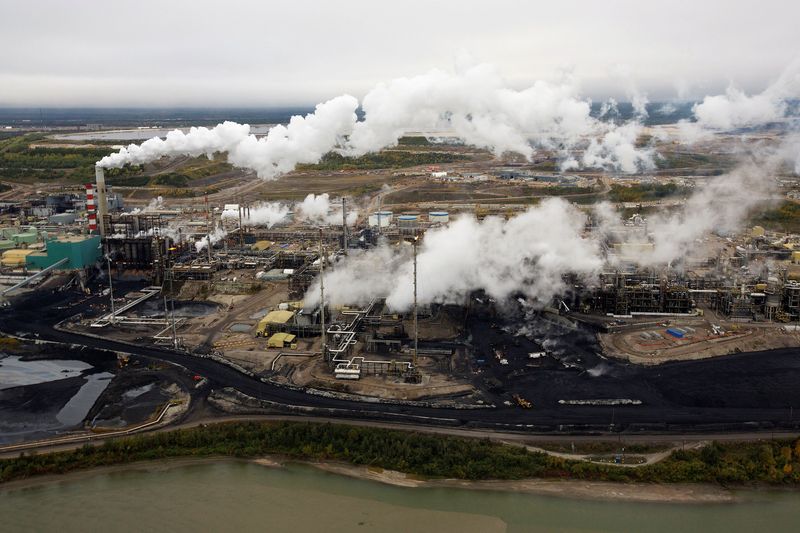(Reuters) -The province of Alberta will toughen its greenhouse gas emissions standards for oil sands mines, closing a loophole that rewarded some of Canada’s highest-emitting facilities with millions of dollars’ worth of tradeable credits, its environment ministry told Reuters.
Alberta is updating industry benchmarks that set emissions reduction requirements per unit of production for mines and upgraders, the ministry said. Canada’s oil sands produce some of the world’s most carbon-intense crude.
The country’s largest oil-producing province has already raised the stringency of facility-based benchmarks, a second way that the government sets emissions standards for industrial sites, according to the ministry.
The government was confirming an earlier Reuters report.
Oil sands mines and upgrading facilities, operated by Canadian Natural Resources, Suncor Energy, Imperial Oil and others, produce heavy emissions due to the energy required to separate oil from Alberta’s sand and clay deposits.
Even so, mines and upgraders collectively generated 2.4 million emissions performance credits in 2020 and were required to pay for 700,000, the first year of a new emissions regulatory system from Premier Jason Kenney’s government, according to public government figures.
That comes out to a net figure of 1.7 million credits, worth about C$54.4 million ($42.67 million) to those oil companies, based on the trade value of about C$32 per credit. Credits trade at around 80% of the federal carbon price, which was C$40 per tonne in 2021, when emitters could use 2020 credits for compliance.
Alberta’s emissions system, called TIER (Technology Innovation and Emissions Reduction Regulation), was not intended to provide credits to oil sands mines, two sources with knowledge of the changes said.
Alberta’s changes will mean that mines and upgraders will no longer financially benefit from their emissions when they account later this year for their 2021 performance, the sources said. They were not authorized to speak publicly.
Kenney’s government overhauled the previous administration’s emissions-reduction system starting in 2020, adding new flexibility for large emitters such as oil sands sites.
Large emitters can choose to measure their emissions intensity, or carbon per barrel, against a facility’s past performance, or against an industry benchmark.
“This is fundamentally the problem, that a facility can show some continuous improvement and gain credits, but still be a high emitter and be a relatively poor emissions performer from its peers,” said Dave Sawyer, an environmental economist who advised a previous Alberta government on managing emissions.
Oil sands total emissions continue to rise as production grows, but emissions per barrel are steadily declining as operators adopt new technology.
“The current loophole is ludicrous but the solution still doesn’t address the fundamental problem: Alberta must reduce its absolute emissions, not its relative emissions,” said Emile Boisseau-Bouvier, climate policy analyst at environmental group Equiterre.
A spokesperson for industry group Canadian Association of Petroleum Producers said it has not seen details of the changes and could not comment.
Alberta’s proposed changes come as the province faces new federal pressure to toughen standards.
Provinces can design their own system to charge emitters for carbon pollution, like Alberta’s TIER, or adopt the federal system. Provinces that use their own system require Ottawa to deem them equivalent with minimum national stringency standards.
Ottawa has deemed TIER equivalent, but is strengthening national criteria starting in 2023 and expects provinces to propose changes to their systems soon to comply, said a spokesperson for Canadian Environment Minister Steven Guilbeault.
Unlike mines, oil sands in situ sites collectively bought more credits than they earned in 2020. This is because they made less progress reducing emissions intensity than mines, one of the sources said.
($1 = 1.2749 Canadian dollars)
(Reporting by Rod Nickel in WinnipegEditing by Marguerita Choy and Leslie Adler)






















